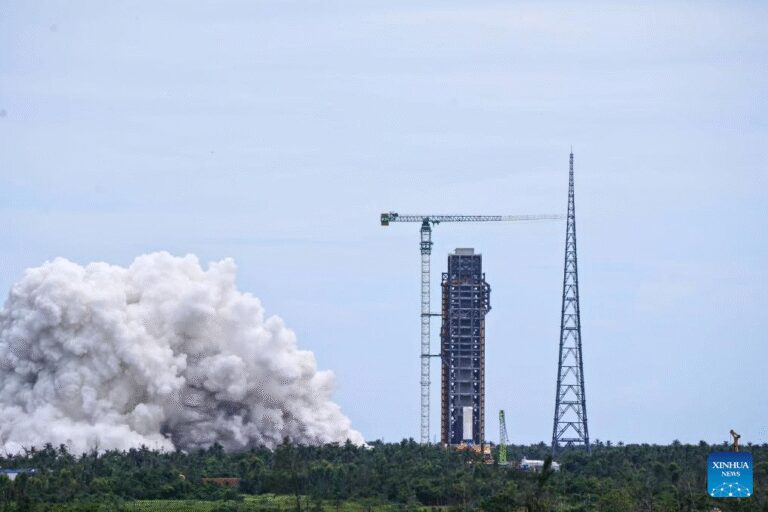
This photo taken on Aug. 15, 2025 shows the static fire test of China’s Long March-10 carrier rocket at the Wenchang Spacecraft Launch Site in south China’s Hainan Province. China’s Long March-10 carrier rocket, the country’s new-generation manned launch vehicle, has successfully completed the first static fire test here on Friday, the China Manned Space Agency has announced. (Xinhua/Zhang Bin)
WENCHANG, Hainan, Aug. 15 (Xinhua) — China’s Long March-10 carrier rocket, the country’s new-generation manned launch vehicle, has successfully completed the first static fire test on Friday at the Wenchang Spacecraft Launch Site in the southern island province of Hainan, the China Manned Space Agency (CMSA) has announced.
This marks a significant new milestone in China’s manned lunar exploration program, following the successful zero-altitude escape flight test of the Mengzhou manned spacecraft and the comprehensive landing and takeoff test of the Lanyue manned lunar lander, according to the CMSA.
At 3:00 p.m. Friday, seven engines of the test product of the rocket’s first stage were ignited simultaneously, followed by the completion of multiple scheduled test procedures.
This static fire test evaluated the simultaneous working capacity of the seven parallel engines of the rocket’s first stage under standard and high working conditions, as well as obtained complete test data. The test was a complete success, the agency said.
The thrust scale in Friday’s test reached nearly 1,000 tonnes, marking the largest such test ever conducted in China.
The Long March-10 carrier rocket series is developed to serve China’s manned lunar exploration missions, including two configurations — the Long March-10 rocket and Long March-10A rocket.
The Long March-10 rocket is a type of three-stage rocket with two boosters. It has a diameter of 5 meters and a maximum height of 92.5 meters. It will undertake the launch missions of the manned spacecraft and the lunar lander.
The Long March-10A is a type of two-stage reusable rocket, with a diameter of 5 meters and a maximum height of 67 meters. Its first stage can be recycled and reused. It will serve the launch missions of the Mengzhou manned spacecraft and Tianzhou cargo craft in the application and development phase of the country’s space station.
The success of the static fire test has laid an important technical foundation for the manned lunar exploration mission, the CMSA said.
The agency stated that the Long March-10 series rockets will be fully utilized in the country’s manned spaceflight program, working in tandem with the Mengzhou manned spacecraft to achieve the upgrading of China’s manned space-Earth round-trip transportation system.
New supporting infrastructure for the country’s manned lunar exploration program is under construction at the Wenchang Spacecraft Launch Site, with all work progressing smoothly, the CMSA said. ■

This photo taken on Aug. 15, 2025 shows the static fire test of China’s Long March-10 carrier rocket at the Wenchang Spacecraft Launch Site in south China’s Hainan Province. China’s Long March-10 carrier rocket, the country’s new-generation manned launch vehicle, has successfully completed the first static fire test here on Friday, the China Manned Space Agency has announced. (Xinhua/Zhang Bin)

This photo taken on Aug. 15, 2025 shows the static fire test of China’s Long March-10 carrier rocket at the Wenchang Spacecraft Launch Site in south China’s Hainan Province. China’s Long March-10 carrier rocket, the country’s new-generation manned launch vehicle, has successfully completed the first static fire test here on Friday, the China Manned Space Agency has announced. (Xinhua/Zhang Bin)

